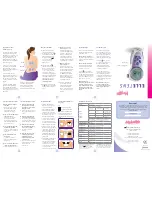
La Crosse Technology, Ltd.
Page 8
•
Consider items in the signal path between the transmitter and the Wireless
Thermometer.
•
Sometime a simple relocation of the transmitter or the Wireless Thermometer will
correct the interference issue.
•
Windows can reflect the radio signal.
•
Metal will absorb the RF (radio frequency) signal.
•
Stucco is backed by a metal mesh that holds it to the wall.
•
Transmitting antennas (ham radio, emergency dispatch center, airports, military bases,
etc.)
•
Electrical wires (utilities, cable, etc.)
•
Vegetation is full of moisture and reduces signal.
•
Dirt: Trying to receive a signal through a hill is difficult.
Wireless Thermometer
How tall are the time numbers?
The time numbers are 0.5 inches tall.
Power requirements
•
2-AA alkaline batteries power the Wireless Thermometer.
12-Hour or 24-Hour time format
•
Display the time in 12-hour or 24-hour format.
•
Default is 12-hour time.
•
Use the
Dashes, HH.H, LL.L or stuck Indoor Temperature
•
This is generally a power related issue.
•
may be overpowered or underpowered. Remove batteries from Wireless
Thermometer.
•
Press any button 20 times. Leave the Wireless Thermometer unpowered for 1-2 hours.
•
Install fresh alkaline batteries with correct polarity.
•
If the indoor temperature is still dashes or OFL, the Wireless Thermometer may need
replacement.
Inaccurate Indoor Temperature reading
•
Side-by-side test: Bring the outdoor transmitter in the house and place it next to the
Wireless Thermometer for 2 hours.
•
Compare indoor and outdoor temperature. The temperature should be within 4
degrees to be within tolerance.




























